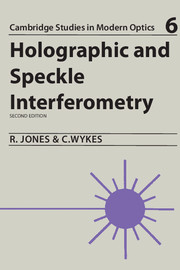Book contents
- Frontmatter
- Contents
- Preface to the first edition
- Preface to the second edition
- Acknowledgements
- 1 Basic optical principles
- 2 Holographic interferometry
- 3 Speckle pattern interferometry
- 4 Electronic Speckle Pattern Correlation Interferometry
- 5 Holographic and speckle pattern interferometry techniques for shape measurements
- 6 Experimental design and technique
- 7 Applications
- Appendices
- References
- Index
Preface to the first edition
Published online by Cambridge University Press: 05 August 2012
- Frontmatter
- Contents
- Preface to the first edition
- Preface to the second edition
- Acknowledgements
- 1 Basic optical principles
- 2 Holographic interferometry
- 3 Speckle pattern interferometry
- 4 Electronic Speckle Pattern Correlation Interferometry
- 5 Holographic and speckle pattern interferometry techniques for shape measurements
- 6 Experimental design and technique
- 7 Applications
- Appendices
- References
- Index
Summary
Holographic and speckle interferometry, which are usually based on laser illumination, enable measurements of displacement (static or dynamic) and shape to be made on optically rough surfaces at sensitivities of the order of the wavelength of light. They can therefore be used to extend the methods of classical optical interferometry to the study of a wide range of objects and systems previously outside the scope of such interferometric investigation. The principle of holographic interferometry was established in the mid-1960s and is based on holographic wavefront reconstruction. Speckle interferometry developed from this work; it relies on the speckle effect which is a random interference pattern observed when coherent light is scattered from a rough surface. In both cases it was the development of lasers capable of generating visible radiation having both high coherence and intensity that enabled the methods to be applied to the solution of practical problems.
Although the techniques are relatively new, their application in such diverse areas as strain and vibration analysis, flow visualization, non-destructive testing and metrology has stimulated a large volume of fundamental and applied research; the results of this work are of considerable importance to a wide range of scientists and engineers. This book provides a self-contained description of the theoretical principles together with a detailed discussion of practical techniques and a survey of applications. The contents may be classified as follows:
Introduction
Chapter 1: This contains an introduction to some basic principles of geometrical optics, diffraction theory, holography and the speckle effect essential to the understanding of the remainder of the book. […]
- Type
- Chapter
- Information
- Holographic and Speckle Interferometry , pp. ix - xPublisher: Cambridge University PressPrint publication year: 1989



